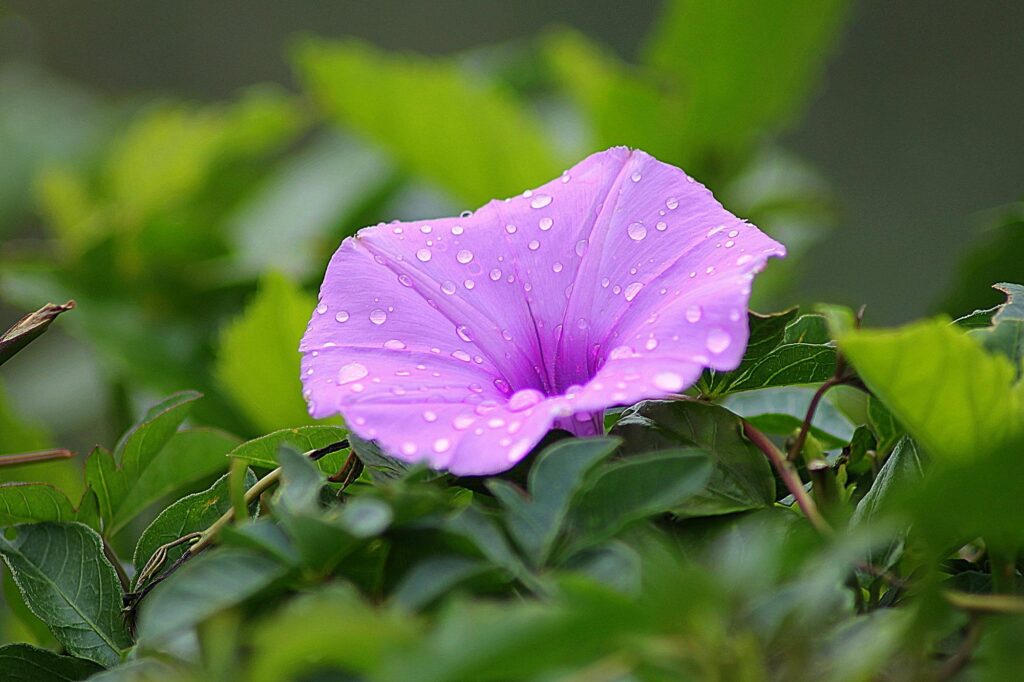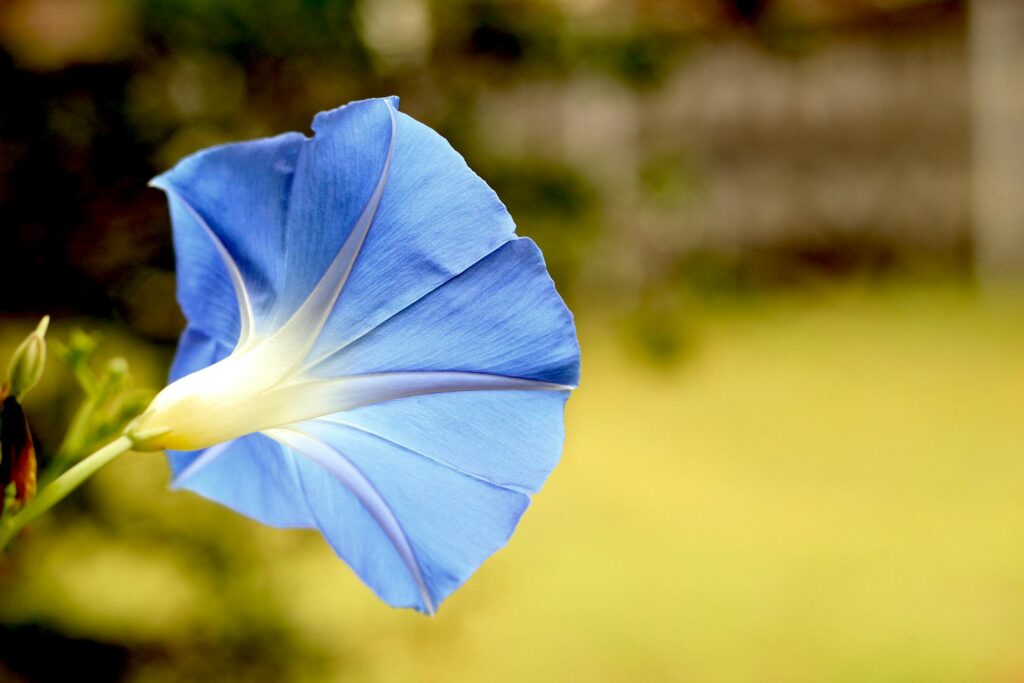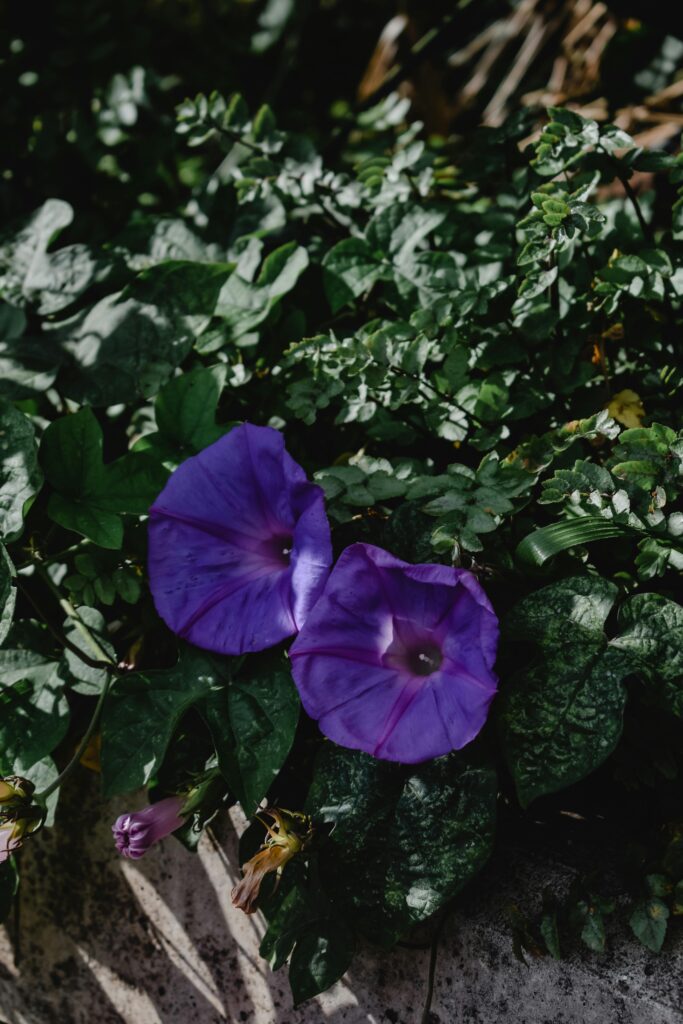Morning Glory Flowers
Few flowers capture the spirit of a new day as beautifully as the morning glory (Ipomoea purpurea and related species). These fast-growing vines unfurl their trumpet-shaped blooms at dawn, offering vibrant blues, purples, pinks, and whites that greet the rising sun. By afternoon, the blossoms close, as if resting until the next day.
Morning glories are more than just flowers—they’re a celebration of renewal, simplicity, and joy. Perfect for trellises, fences, or even balcony railings, they bring vertical beauty wherever they grow. And with just a little care, they reward gardeners with abundant blooms from summer until frost.
Let’s explore everything you need to know to grow and care for these stunning vines.

Why Grow Morning Glories? 🌸
Morning glories are cherished for many reasons:
- Fast climbers: Perfect for covering fences, trellises, or unsightly walls in just a season.
- Vibrant colors: Their blossoms glow in deep purples, electric blues, pinks, and whites.
- Pollinator-friendly: Loved by bees, butterflies, and hummingbirds.
- Easy growers: Adaptable, low-maintenance, and quick to thrive.
- Romantic charm: Their daily rhythm of opening and closing adds magic to gardens.
Symbolically, morning glories represent affection, resilience, and new beginnings—a poetic reminder every morning.

Ideal Growing Conditions 🌱
Sunlight
Morning glories require full sun for best flowering—at least 6–8 hours daily. Without enough sunlight, vines grow but produce fewer blooms.
Soil
- Prefer well-draining soil.
- Morning glories thrive in moderately fertile soil—too much fertility encourages foliage over flowers.
- pH: 6.0–7.5.
Water
- Water seedlings regularly until established.
- Mature plants are drought-tolerant; water deeply once a week during dry spells.
- Avoid waterlogging, which causes root issues.
Climate
- Thrive in warm climates and are frost-sensitive.
- Best grown as annuals in temperate zones, but in frost-free regions, some species act as perennials.
- Ideal temperature: 65–85°F (18–29°C).
Types of Morning Glories 🌼
- Ipomoea purpurea (Common Morning Glory): Heart-shaped leaves, vibrant purple, blue, and pink flowers.
- Ipomoea tricolor: Famous for the ‘Heavenly Blue’ variety with sky-blue blooms.
- Ipomoea nil (Japanese Morning Glory): Known for elaborate colors and patterns.
- Ipomoea quamoclit (Cypress Vine): Delicate foliage with small star-shaped blooms.
- Moonflower (Ipomoea alba): A night-blooming cousin with large, white, fragrant blossoms.

Planting Morning Glories: Step by Step 🌿
1. Preparing Seeds
Morning glory seeds have a hard outer coat. For better germination:
- Soak seeds overnight in warm water.
- Or nick the seed coat gently with sandpaper.
2. Sowing Outdoors
- Plant seeds directly outdoors after the last frost.
- Sow seeds ½ inch deep and 6–12 inches apart.
- Provide a trellis, fence, or netting for vines to climb immediately.
- Germination takes 5–14 days.
3. Starting Indoors
- Start seeds indoors 4–6 weeks before the last frost.
- Use peat pots to avoid disturbing roots during transplant.
- Transplant carefully once soil warms.
4. Container Growing
- Choose a large pot with drainage holes.
- Add a trellis or support for climbing.
- Place in a sunny location for maximum blooms.
Daily Care Tips 🌞
- Watering: Keep soil evenly moist, but allow it to dry between waterings.
- Feeding: Avoid high-nitrogen fertilizers; use a balanced, slow-release formula once or twice in the season.
- Training Vines: Gently guide stems onto trellises or fences—morning glories twine naturally.
- Mulching: Add a light layer of mulch to retain moisture and suppress weeds.

Pruning and Maintenance ✂️
- Trim back overgrown vines to maintain shape and encourage new blooms.
- Deadhead faded flowers to prevent excessive self-seeding (morning glories can spread quickly).
- Remove any weak or tangled stems for healthier growth.
Common Pests and Problems 🐛
Morning glories are relatively problem-free, but a few issues may arise:
- Aphids: Spray with water or use neem oil.
- Spider mites: Look for webbing; treat with insecticidal soap.
- Leaf miners: Cause trails in leaves; remove damaged leaves.
- Overgrowth/self-seeding: Morning glories can become invasive if not managed. Collect seeds before they spread too widely.
Propagation 🌱
Morning glories are most commonly grown from seeds, but here are key methods:
1. Seed Sowing
Easiest and most reliable method. Direct sowing outdoors is best.
2. Self-Seeding
Morning glories often reseed naturally. Collect pods before they scatter if you want control.
3. Stem Cuttings (Less Common)
Some gardeners root green stem cuttings in water or soil, though it’s not as reliable as seeds.
Expert Tips for Success 🌟
- Soak seeds: It speeds up germination.
- Provide support early: Vines grow fast and need direction.
- Don’t over-fertilize: Too much nitrogen means leaves instead of flowers.
- Watch for invasiveness: In some regions, they can spread aggressively.
- Mix varieties: Combine morning glories with moonflowers for day-and-night blooms.

Seasonal Care Calendar 🌸
- Spring: Soak and sow seeds after frost. Train seedlings to climb.
- Summer: Regular watering, enjoy vibrant blooms, light pruning.
- Fall: Collect seeds before frost, cut back vines, compost spent plants.
- Winter: In frost-free zones, protect perennials; otherwise, plan for replanting next spring.
FAQs About Morning Glories ❓
1. Do morning glories come back every year?
Most are annuals, but in warm, frost-free climates, some species (like Ipomoea indica) can be perennial.
2. Why aren’t my morning glories blooming?
Too much nitrogen fertilizer or not enough sun can result in leafy vines without flowers.
3. Can morning glories grow in pots?
Yes! With a large pot and proper support, they thrive beautifully on patios or balconies.
4. Do morning glories need pruning?
Not required, but trimming helps manage growth and prevent invasiveness.
5. How tall do morning glories grow?
They can climb 10–15 feet or more in one season with the right support.
6. Are morning glory seeds poisonous?
Yes. Seeds can be toxic if ingested in large quantities, so keep them away from pets and children.
7. When do morning glories bloom?
Typically from mid-summer until the first frost.
Conclusion: A Flower That Welcomes the Day 🌺
Morning glories are a delightful reminder that every day is a fresh start. With their fast growth, enchanting blooms, and minimal needs, they bring instant beauty and charm to gardens big and small. Whether you’re covering a fence, brightening a balcony, or simply enjoying their sunrise ritual, morning glories reward you with color, life, and cheer.
This season, plant morning glories and let them greet your mornings with joy and beauty. 🌞🌸



